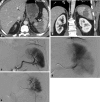Update: Splenic Artery Embolization in Blunt Abdominal Trauma
- PMID: 32139975
- PMCID: PMC7056344
- DOI: 10.1055/s-0039-3401845
Update: Splenic Artery Embolization in Blunt Abdominal Trauma
Abstract
The spleen is the most commonly injured organ after blunt abdominal trauma. Nonoperative management with splenic arterial embolization (SAE) is the current standard of care for hemodynamically stable patients. Current data favor the use of proximal and coil embolization techniques in adults, while observation is suggested in the pediatric population. In this review, the authors describe the most recent evidence informing the clinical indications, techniques, and complications for SAE.
Keywords: blunt splenic injury; interventional radiology; splenic arterial embolization; trauma.
© Thieme Medical Publishers.
Conflict of interest statement
Conflict of Interest None of the authors have conflicts.
Figures



References
-
- Ahuja C, Farsad K, Chadha M. An overview of splenic embolization. AJR Am J Roentgenol. 2015;205(04):720–725. - PubMed
-
- Sclafani S J. The role of angiographic hemostasis in salvage of the injured spleen. Radiology. 1981;141(03):645–650. - PubMed
-
- Bisharat N, Omari H, Lavi I, Raz R. Risk of infection and death among post-splenectomy patients. J Infect. 2001;43(03):182–186. - PubMed
-
- Organ injury scaling 2018 update: spleen, liver, and kidney: erratum. J Trauma Acute Care Surg. 2019;87(02):512. - PubMed

